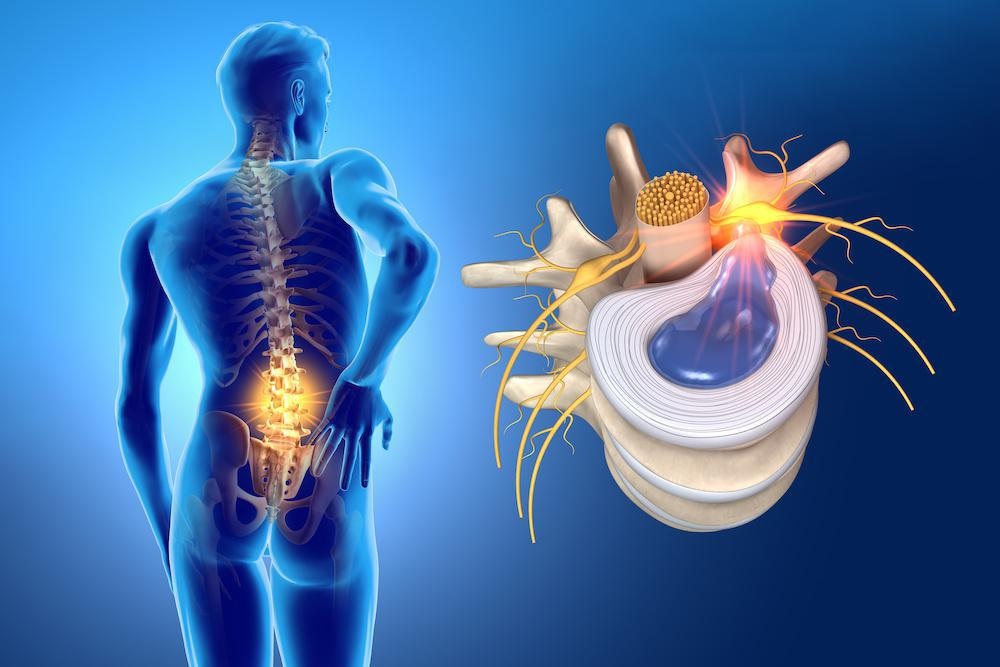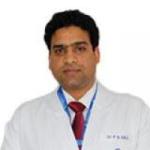What is
Disc herniation occurs when an intervertebral disc degenerates and deteriorates, causing the inner nucleus to leak into a weakened area on the outside of the disc.
The weak point in the outer nucleus of the intervertebral disc is directly below the spinal nerve root, so a herniation in this area can put direct pressure on nearby nerves or the spinal cord.
Therefore, herniated discs are sometimes a cause of radiculopathy, which encompasses any disease that affects the nerve roots of the spine.
Dr Ashu Consul, best orthopaedic in Dwarka, consultant at Venkateshwara Hospital, adds that, initially, herniated discs can be confused with the following pathologies: “piriformis syndrome, facet arthropathies, deep gluteal syndrome, peripheral neuropathies, muscle trigger points and, in more severe cases, tumors”.
Causes
The vertebrae of the spine are separated by discs that cushion movement and leave space between the vertebrae. In the same way, they allow their movement, which makes it possible to bend down or stretch out.
In addition, the vertebrae of the spine protect the spinal cord that comes from the brain and runs down the back to the lower back. The discs fulfill a very important function of cushioning and distribution of loads and any damage to them can be serious if not treated quickly.
The disc can move out of place, that is, herniate, or rupture due to injury or stress. This can cause excess pressure on the spinal nerves resulting in pain, numbness or weakness in the patient.
Normally, herniated discs are located in the lumbar region, with the second most affected area being the cervical discs (the neck).
Symptoms
A cervical disc herniation can cause pain in the neck, which in turn can radiate to the arm, shoulder, or can cause numbness or tingling in the arm or hand. Sometimes the pain can be dull, constant, and difficult to locate.
In addition to this pain, the symptoms of herniated discs are the following:
- The first sign that the patient has a herniated disc is pain in the arms and neck. If numbness or tingling occurs it may indicate that the problem is more serious.
- Typically, the patient complains of sharp, cutting pain, and in some cases, there may be a prior history of episodes of localized pain, present in the back and radiating down the leg.
- The episode of pain may come on suddenly or be heralded by a tearing or snapping sensation in the spine.
- When the pain starts slowly, it can worsen after the patient spends a long time sitting, standing, at night, when sneezing, coughing or laughing.
- Weakness is also a common symptom that affects the leg or arm and may require excessive effort to move them.
- Usually, the numbness or weakness goes away over a period of several weeks or months.
Prevention
According to Orthopaedic in Dwarka, “exercising regularly and appropriately is important. Also avoiding leading a sedentary lifestyle, being overweight and smoking helps prevent this type of back pathology. Finally, avoid unnecessary risks such as lifting heavy objects, improperly bending or twisting the lower back, or sitting or standing in the same position for many hours and in an unergonomic way.
Types
There are three degrees:
- Disc protrusion: when the nucleus pulposus has not yet come out of the annulus fibrosus, it is therefore weaker and gives way in its structure. This is the first stage of a herniated disc.
- Disc herniation: the material of the nucleus pulposus is ejected from the limits of the annulus fibrosus.
- Disc extrusion: the exit of the disc material is violent and breaks the posterior common vertebral ligament, leaving free fragments in the vertebral canal.
Diagnosis
To diagnose a herniated disc, the orthopaedic doctor in Delhi will carry out a medical examination of the spine, arms and lower extremities. Depending on the region where the patient’s symptoms are located, the orthopaedic in Delhi will look for possible numbness or loss of sensitivity.
In addition, he will test your muscle reflexes, which may have been affected and slowed down or even disappeared. He will also study the patient’s muscle strength and the shape of the curvature of the spine.
On the other hand, the patient may also be asked to sit, stand or walk, bend forward, backward or sideways and move the neck, shoulders or hands.
Diagnostic tests that can verify the existence of a herniated disc are:
- An electromyography that will determine which nerve root is affected and where it is compressed.
- A myelography to specify the size and location of the hernia.
- An MRI that will show if there is pressure on the spinal cord.
- Finally, an X- ray of the spine may also be performed to rule out other injuries that cause cervical or back pain.
Treatments
The first treatment given to patients with this condition is short rest and pain medication, followed by a period of physiotherapy session with physiotherapist in Dwarka. In most cases, almost immediate recovery occurs, but in other cases medication or injections may be required.
In the case of corticosteroids, they are usually administered, above all, non-steroidal anti -inflammatory drugs to control pain and also muscle relaxants.
Injections into the area of your back where the herniated disc is located can help control pain for a few months. In addition, these injections greatly reduce the swelling of the disc.
The last option is microdiscectomy, considered as the surgery that is used to relieve pressure on the nerve root and allow the nerve to recover more effectively. This type of intervention does not entail great difficulty, since it is usually enough with a small incision and one night of admission.
Regarding the therapeutic approach to herniated discs, Orthopaedic in West Delhi states that “one of the most important advances has occurred in the increased precision of diagnostic tools, which has made treatment much more effective and specific, both in management conservative as in the surgical. From the surgical point of view, the trend is towards minimally invasive, what we commonly know as microsurgery, so that the tissues suffer the least negative impact after the surgical intervention”.
At what age do herniated discs usually appear?
“Disc herniation can appear at any age, since its causes are multifactorial. Although, it begins to be more frequent in the range of 30 to 50 years of age. And they are more prevalent after the age of 50, where it is estimated that more than 80% of the population begins to show disc degeneration”, says orthopedic in Delhi.
- When to visit an orthopaedic specialist
- The revolution of robotic knee replacement surgery
- Pelvic floor fracture in males: symptoms, problems, and treatment
- Hip injuries: types, symptoms, prevention and surgery
- Disc herniation
- Achilles tendon rupture - treatment, surgery
- Hip osteoarthritis treatment


 Comments (
Comments ( Category (
Category ( Views (
Views (